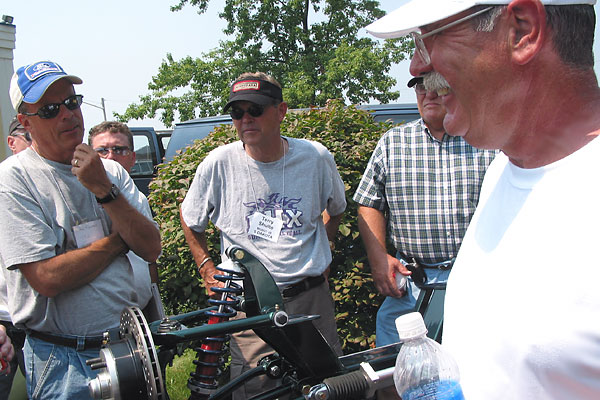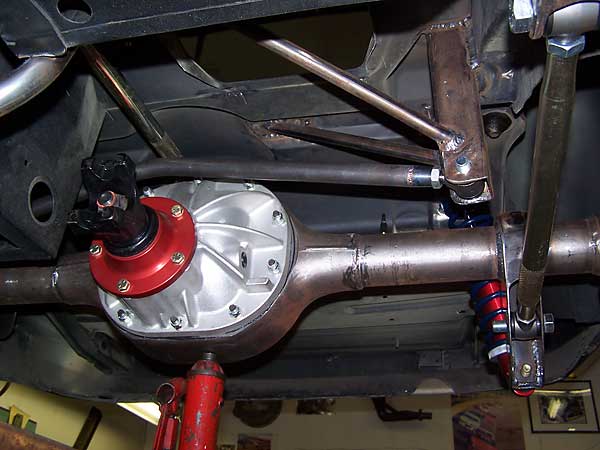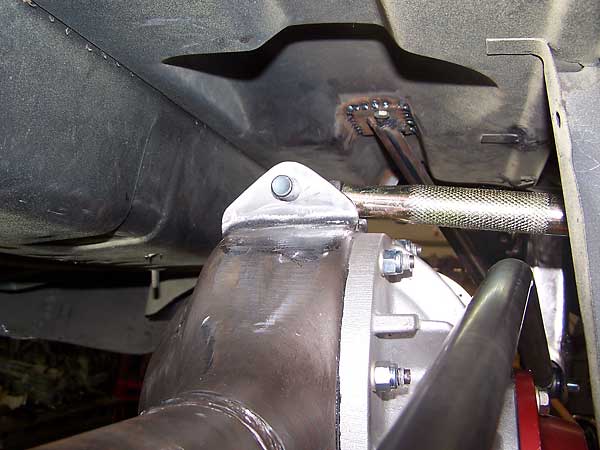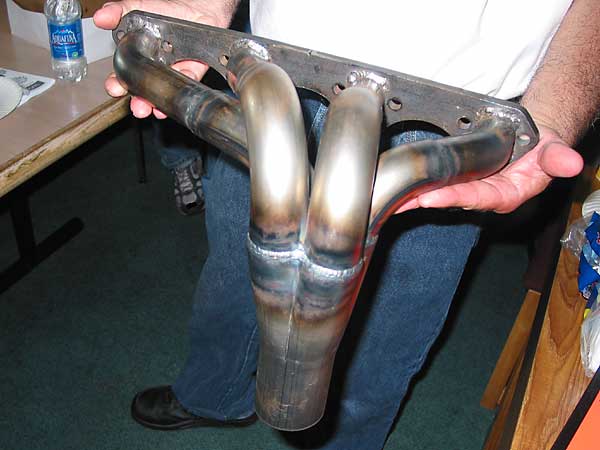
Ted Lathrop Discusses the Fast Cars Front Suspension with Dale Knapke and Terry Shulte
British V8 2007 Tech Session: Fast Cars MGB Front & Rear Suspensions
as published in British V8 Newsletter, Volume XV Issue 2, September 2007presented by: Ted Lathrop of Fast Cars Inc.
coverage by: Curtis Jacobson
The purpose of Ted's 2pm tech session was to walk us through his design process and to explain the theory of operation behind his resulting designs.

The new Fast Cars 3-link MGB rear suspension is designed around the Ford 8" rear axle.
Ted Lathrop prefers this axle for its light weight (plus gear, differential, & brake options.)
Fast Cars 3-Link MGB Rear Suspension
The first point Ted emphasized about his brand new 3-link rear suspension was that he DIDN'T re-invent the wheel! Ted asserts that three-link suspensions are the most common configuration in American racing (and especially sports car racing). Why are they so popular? Because they're lightweight! Ted continued that unsprung weight isn't just about handling... it's also about ride quality.Ironically, a three-link suspension is usually composed of four links (plus two coilover shock absorbers.) The three links that extend forward locate the axle forward-to-back and restrict its rotation (e.g. pinion angle). The fourth link is a Panhard rod, which keeps the axle located side-to-side.
Getting the linkage geometry just right is very important! If a three-link suspension is designed and adjusted properly, it can have better handling characteristics than a stock leaf-sprung ("Hotchkiss") suspension in terms of anti-squat, roll understeer, and minimized brake hop. On the other hand, if the suspension were poorly designed it could cause dangerous handling problems. (Momentary binding in a link pivot could, for example, cause an erratic jerking behavior in a turn.) Ted has put a lot of work into developing his new suspension to make sure the design is safe and effective.
Ted emphasized the inherent anti-squat characteristics of the Fast Cars
three-link suspension. If you watch most cars accelerate from a stop,
the weight of the body shifting rearward tends to compress the rear springs
and thus cause the rear end of the car to move downward. (This is analogous
to what happens at the front-end under braking conditions; the front ends of
most cars "dive" downward under hard braking.) By designing the rear suspension
geometry to incorporate "anti-squat", rearward weight transfer under acceleration
can be turned more efficiently into increased traction. (An ideally set-up
sports car, in Ted's opinion, stays basically level under straight-line
acceleration or deceleration. However, the whole body will tend to lift
up slightly under acceleration and also hunker down slightly under braking.)

This is how the "top link" bracket is mounted above the differential in Ted's rear suspension.
The "top link" runs forward from the top of the differential to a point on
the body above the driveshaft tunnel. In configuring the top link, Ted
advises that you always want this link to run "downhill" towards the front.
For an MGB installation, Ted recommends that the downward angle should be
about 3 degrees. When developing a three-link, the mounting bracket on the
chassis should also preferably provide height adjustment so that different
angles can be tested. The top link pivot on the axle should usually be as
low on the axle as you can get it.
In plan-view, the top link is usually mounted on body/axle centerline, but Ted also mentioned that racers sometimes bias a car's handling by moving the top link off-center.
The two bottom links run forward from brackets underneath the axle. With Ted's design, they're parallel with each other. (This is a nice feature because it simplifies suspension alignment.) The two links are about as far outboard as leaf springs would've been. In locating the bottom links, Ted advises that you want them running a little bit "uphill" towards the front mounts. Nominally, the front mounts for Ted's MGB three-link are the rubber-bumper leaf-spring mounts (although Ted actually reconstructs them and adds structural reinforcements forward under the MGB floor.)
On the axle, does it matter how far forward or rearward the link mounting/pivot points are? Possibly not, but Ted prefers to center the pivots so they're all on one vertical plane and aligned with the centerline of the axle.

Interestingly, Ted mounts his Panhard rod in front of the axle. The MGB
fuel tank makes things a bit crowded rearward of the axle. To clear the
axle pinion, Ted's forward-mounted Panhard rod has to have a "dog-leg"
bent into it. As defined by its end-points, Ted has the Panhard rod mounted
level and at the rear axle's centerline height. The resulting roll-center of
Ted's three-link rear suspension is thus very near axle centerline height,
and also very near the roll-center height of a stock MGB. Further explanation
of why this is of interest is beyond the scope of this article except to
say in extremely quick summary that roll center height has a lot of bearing
on both (a) how much weight is transferred between tires side-to-side in
turns and (b) how much the driver perceives body roll.
One of the rules of thumb about Panhard rods is that they should be as long as feasible so that their slight rotation as the suspension goes up and down will have minimal tendency to force the axle right or left relative to the body. In fact, Ted stated another rule of thumb: in general, when it comes to suspension links, the longer the better.
All four of Ted's links have "Nylatron GS" bushings at both ends in lieu of Heim joints (which would transmit more road noise and would probably wear out quicker) or rubber bushings.
With Ted's three-link suspension, the original MGB rubber bump stops and rebound straps are no longer required. At this point in Ted's presentation, Ted's first three-link customer Terry Shulte indicated that he hadn't comprehended this and had installed the rubber bump stops anyway. Ted said he didn't think they'd hurt anything; they're just not needed. Overall rear suspension travel may be somewhat more than stock (in droop), but not much. Increased available suspension travel wasn't one of the design goals.
Ted recommends taking the car out for a digital chassis alignment after installation.
Ted has placed his coilover shocks behind the axle, mounted straight up and down.
Nominally, Ted's three-link suspension's ride height is just below chrome-bumper ride height... but of course it's easily adjustable by rotating the spring perches on the coilover shocks. For the performance minded, rotating the spring perches is a tuning feature. Corner weights can be balanced side-to-side to optimize tire loading.
What does the Fast Cars 3-Link MGB rear suspension cost? You'll want to call Ted directly to discuss your specific application because there are a number of variables that can substantially affect price. Among other issues, installing the 3-Link rear suspension will require excellent welding skill and also reinforcement of the car's body. Ted anticipates that most customers will elect to have his shop do the actual installation.

Please see The MGB Front Suspension Upgrade for more information.
Fast Cars is now using QA1 brand shock absorbers. (They were using Carrara shocks, but Carrara got bought out by QA1.)
The Fast Cars IFS uses a custom made steering rack. This year Ted added that the rack has a somewhat slower than stock ratio. He also noted that it comes with one u-joint, and user normally provides the second u-joint at top of an intermediate shaft. Ted can provide these components on a separate basis. Travel of the rack isn't adjustable (with positive stops) lock-to-lock.

This is how the "top link" bracket is mounted above the differential in Ted's rear suspension.
In plan-view, the top link is usually mounted on body/axle centerline, but Ted also mentioned that racers sometimes bias a car's handling by moving the top link off-center.
The two bottom links run forward from brackets underneath the axle. With Ted's design, they're parallel with each other. (This is a nice feature because it simplifies suspension alignment.) The two links are about as far outboard as leaf springs would've been. In locating the bottom links, Ted advises that you want them running a little bit "uphill" towards the front mounts. Nominally, the front mounts for Ted's MGB three-link are the rubber-bumper leaf-spring mounts (although Ted actually reconstructs them and adds structural reinforcements forward under the MGB floor.)
On the axle, does it matter how far forward or rearward the link mounting/pivot points are? Possibly not, but Ted prefers to center the pivots so they're all on one vertical plane and aligned with the centerline of the axle.

One of the rules of thumb about Panhard rods is that they should be as long as feasible so that their slight rotation as the suspension goes up and down will have minimal tendency to force the axle right or left relative to the body. In fact, Ted stated another rule of thumb: in general, when it comes to suspension links, the longer the better.
All four of Ted's links have "Nylatron GS" bushings at both ends in lieu of Heim joints (which would transmit more road noise and would probably wear out quicker) or rubber bushings.
With Ted's three-link suspension, the original MGB rubber bump stops and rebound straps are no longer required. At this point in Ted's presentation, Ted's first three-link customer Terry Shulte indicated that he hadn't comprehended this and had installed the rubber bump stops anyway. Ted said he didn't think they'd hurt anything; they're just not needed. Overall rear suspension travel may be somewhat more than stock (in droop), but not much. Increased available suspension travel wasn't one of the design goals.
Ted recommends taking the car out for a digital chassis alignment after installation.
Ted has placed his coilover shocks behind the axle, mounted straight up and down.
Nominally, Ted's three-link suspension's ride height is just below chrome-bumper ride height... but of course it's easily adjustable by rotating the spring perches on the coilover shocks. For the performance minded, rotating the spring perches is a tuning feature. Corner weights can be balanced side-to-side to optimize tire loading.
What does the Fast Cars 3-Link MGB rear suspension cost? You'll want to call Ted directly to discuss your specific application because there are a number of variables that can substantially affect price. Among other issues, installing the 3-Link rear suspension will require excellent welding skill and also reinforcement of the car's body. Ted anticipates that most customers will elect to have his shop do the actual installation.

Fast Cars Independent Front Suspension
This newsletter covered a tech session on the Fast Cars front suspension in great detail last year. Instead of re-inventing the wheel, this article will only add a few new points that came up in this year's tech session.Please see The MGB Front Suspension Upgrade for more information.
Fast Cars is now using QA1 brand shock absorbers. (They were using Carrara shocks, but Carrara got bought out by QA1.)
The Fast Cars IFS uses a custom made steering rack. This year Ted added that the rack has a somewhat slower than stock ratio. He also noted that it comes with one u-joint, and user normally provides the second u-joint at top of an intermediate shaft. Ted can provide these components on a separate basis. Travel of the rack isn't adjustable (with positive stops) lock-to-lock.
Ted explained that his front suspension mounts as a unit just as the original MGB
front suspension did (with four fasteners). Abingdon used special shouldered studs
(with locking nuts on both ends) to avoid over-compression of rubber pads between
the axle and the body. Ted strongly prefers that the front suspension be metal-to-metal
mounted with conventional bolts. We discussed this a little in the tech session.
Back in the day, MG tested metal-to-metal mounting and even welding in the front
crossmember. In the book MGB, including MGC & MGB GT V8, David Knowles
wrote that "Excessive noise was found to be caused by an experiment to weld in the
front cross-member (set out as ADO23/820, dated 6 October 1961), and in the end the
cross-member was bolted in conventionally." Of course, lots of other car models
including old Buick Specials and nearly all trucks have metal-to-metal bolted-in
front suspension crossmembers. (Note: molded polyurethane pads are now available
in two different hardnesses to replace the stock rubber pads for people who want
to split the difference.)
Ted cleared up a little confusion about track-width options. The Fast Cars IFS is available in 51" and 53" wide versions. Between the two, the length of control arms stays the same. The steering rack stays same.
Ted took a question about residual pressure valves in the brake system. Ted uses a 2# residual valve for disc brakes and a 10# residual valve for drum brakes. (The purpose of a residual pressure valve is to keep excessive fluid from draining back out of calipers, which makes a big difference in pedal feel.) Ted mounts them per the instructions on the box, as close to the master cylinder as feasible.
Another person asked for more information about the spindles. Ted volunteered that the spindles are made from 4130 (chrome-moly) steel, and the hubs are made from 6061 aluminum alloy. They use Timken tapered roller wheel bearings. The spindle assemblies weigh 5 pounds 2 ounces each (without brakes).

Disclaimer: This page was researched and written by Curtis Jacobson. Views expressed are those of the author, and are provided without warrantee or guarantee. Apply at your own risk.
Photos by Curtis Jacobson and Dan Masters (construction photos, used by exclusive permission) for The British V8 Newsletter. All rights reserved.
Ted cleared up a little confusion about track-width options. The Fast Cars IFS is available in 51" and 53" wide versions. Between the two, the length of control arms stays the same. The steering rack stays same.
Ted took a question about residual pressure valves in the brake system. Ted uses a 2# residual valve for disc brakes and a 10# residual valve for drum brakes. (The purpose of a residual pressure valve is to keep excessive fluid from draining back out of calipers, which makes a big difference in pedal feel.) Ted mounts them per the instructions on the box, as close to the master cylinder as feasible.
Another person asked for more information about the spindles. Ted volunteered that the spindles are made from 4130 (chrome-moly) steel, and the hubs are made from 6061 aluminum alloy. They use Timken tapered roller wheel bearings. The spindle assemblies weigh 5 pounds 2 ounces each (without brakes).

Fast Cars Through-the-Fender Headers for MGB-V8 (Ford) Swaps
Ted has another new product! As shown in the photo, he has set up to offer four-into-one headers for Ford 302 based MGB engine swaps. Ted got into this business by acquiring Coyote Headers from Steve Carrick, and these new headers are a development on the headers Steve Carrick originally developed. They're configured a little differently to make the runners closer to equal length. Contact Ted for details!Disclaimer: This page was researched and written by Curtis Jacobson. Views expressed are those of the author, and are provided without warrantee or guarantee. Apply at your own risk.
Photos by Curtis Jacobson and Dan Masters (construction photos, used by exclusive permission) for The British V8 Newsletter. All rights reserved.


